Kentucky, often called the Bluegrass State, has a rich tapestry of history that tells the story of its settlers, wars, and the strategic importance of its location.
Many historic sites dot its landscape, but the historic forts in Kentucky, primarily from the American Civil War era, remain of special interest to history buffs.
With its location by the Ohio River and central to multiple states, Kentucky was a critical frontier during times of war.
Historic Forts in Kentucky
| 1. Fort Boonesborough | 6. Fort Nelson |
| 2. Old Fort Harrod State Park | 7. Fort Knox |
| 3. Fort Duffield | 8. Fort Heiman |
| 4. Fort Thomas | 9. Fort Mitchell |
| 5. Fort Hill | 10. Fort Southworth |
1. Fort Boonesborough
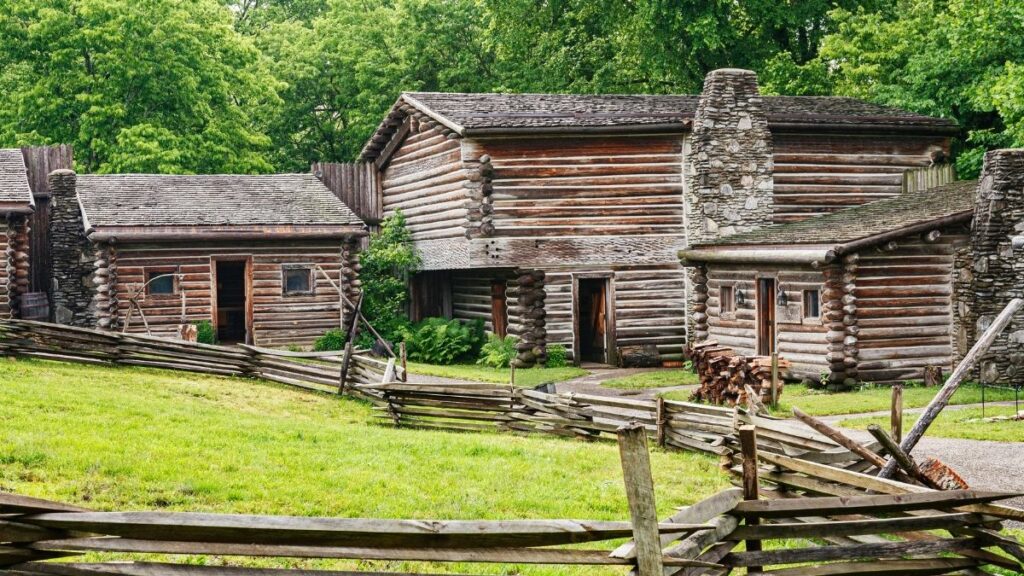
Fort Boonesborough is a vibrant emblem of the early American pioneering spirit in Kentucky’s scenic landscape. Founded in 1775 by the iconic frontiersman Daniel Boone, this location wasn’t solely a protective fortification.
Represented the heart of Kentucky’s first permanent settlement, symbolizing the aspirations and resilience of those who dared to carve a new life out of the wilderness.
The Fort’s Architecture and Replicas
Visitors today are welcomed to a meticulously recreated version of the original fort. Offering a tangible journey into the past, this full-scale replica showcases the architectural ingenuity of the time, most notably in the form of its traditional log cabin.
Within these wooden walls, stories of survival, community, and perseverance come alive, painting a vivid picture of the challenges and triumphs faced by the 18th-century settlers.
A treasure trove of information awaits at the fort’s visitor center. Through interactive displays, artifacts, and engaging narratives, guests can further explore the intricacies of Fort Boonesborough’s storied past.
Knowledgeable guides are also on hand to lead immersive guided tours, providing insights into the fort’s strategic importance, daily life, and the indomitable spirit of its inhabitants.
Events and Initiatives by the Fort Boonesborough Foundation
The Fort Boonesborough Foundation, dedicated to preserving and promoting the fort’s legacy, orchestrates a range of special events throughout the year.
From historical reenactments and traditional craft workshops to enlightening lectures, these events educate, entertain, and honor the pioneers’ enduring influence.
The Pioneer Cemetery: Echoes of the Past
Adjacent to the fort lies a poignant reminder of the early settlers: the pioneer cemetery. This tranquil space, marked by time-worn tombstones, pays homage to many of Fort Boonesborough’s inaugural residents.
A walk among these graves instills a deep reverence for the pioneers’ fortitude and the sacrifices they made to shape Kentucky’s future.
2. Old Fort Harrod State Park
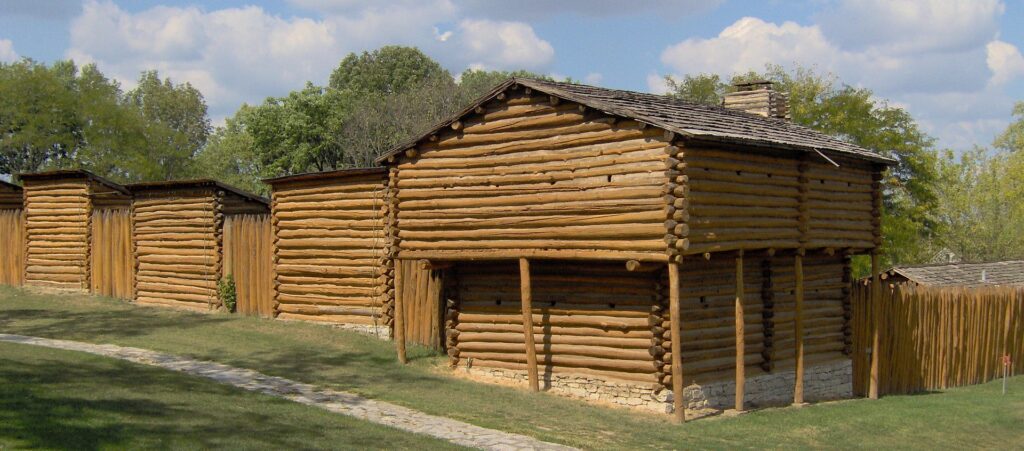
Located in Harrodsburg, Old Fort Harrod State Park is a dedicated monument to the pioneering spirit of James Harrod. Harrod’s contributions are intricately woven into the state’s foundational history as the visionary behind Kentucky’s first enduring settlement.
A faithful replica of the original fort stands at the park’s heart. Constructed with meticulous attention to historical detail, the fort offers visitors an authentic experience of Kentucky’s early settlement life.
The wooden walls and structures, reminiscent of the era, tell tales of survival, unity, and the human spirit’s indomitable will.
Lincoln Marriage Temple: A Glimpse into the Life of a Legend
One of the park’s most notable attractions is the Lincoln Marriage Temple. Sheltering the log cabin where Abraham Lincoln’s parents exchanged their wedding vows, the temple serves as a poignant reminder of the president’s humble beginnings.
Visitors are transported to Lincoln’s days through educational programs and displays, exploring his personal ties to Kentucky and his larger-than-life national legacy.
Educational Expeditions: From Settlement to Survival
The state park is a place of historical reflection and a learning hub. Through various educational programs, visitors can delve into the myriad challenges the early settlers confronted.
Most prominent among these were the frequent Indian attacks, which tested the settlers’ resolve and resourcefulness. Interactive sessions, guided tours, and reenactments bring these historical episodes to life, providing a comprehensive understanding of the risks and rewards of frontier living.
3. Fort Duffield
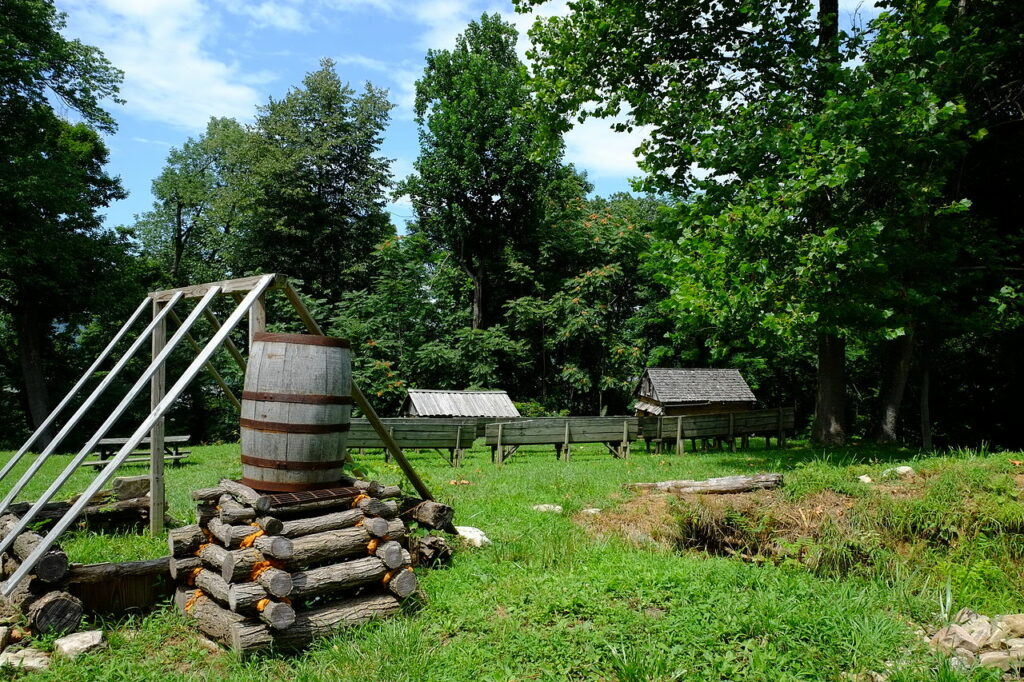
Perched in West Point, Fort Duffield offers a panoramic view of where the Salt River melds with the Ohio River.
This strategic confluence made the fort invaluable, providing a natural vantage point and facilitating control over the region’s waterways.
Transformed into the present-day Fort Duffield Park, the area now serves as a reminder of the fort’s historical significance.
Majestic trees, well-maintained paths, and interpretive signage combine to create a serene yet educational environment. Visitors can meander through the park, absorbing its natural beauty and storied past.
The Valor of the Union: A Fort Under Siege
Perhaps the most compelling chapter in the fort’s history revolves around the brave Union soldiers stationed there.
Under constant threat and facing formidable odds, these soldiers valiantly defended Fort Duffield from potential conquest by Confederate forces, most notably those led by General John Hunt Morgan. Their unwavering dedication ensured the fort remained a bastion of Union strength throughout the conflict.
Echoes of the Past: Remembering the Soldiers
Today, the fort not only stands as a testament to military strategy and territorial disputes but also as a monument to the individual soldiers’ courage and sacrifice.
Their stories of bravery, camaraderie, and resilience are etched into the very soil of Fort Duffield, making it a hallowed ground for history enthusiasts and casual visitors alike.
4. Fort Thomas

Fort Thomas is a beacon of American history in what is now known as Franklin County. Amidst its scenic beauty, the fort holds tales of determination, training, and the shaping of soldiers ready for battle.
While today’s visitors are treated to the natural splendors of Fort Thomas, the lush landscapes and serene vistas tell a deeper story. Every tree, pathway, and stone in Fort Thomas has witnessed the rigorous preparations of men destined for war.
The Crucible of War: A Union Training Hub
During a tumultuous time in American history, Fort Thomas emerged as a pivotal training camp for Union troops. Here, raw recruits were transformed into disciplined soldiers, ready to face the challenges of the battlefield.
The drills, camaraderie, and spirit of the Union echoed through the grounds, shaping the very essence of Fort Thomas.
Today’s Fort Thomas: Blending Nature and History
Now a hub of natural beauty and tranquility, Fort Thomas seamlessly melds its historical significance with the allure of the outdoors.
While hikers, nature enthusiasts, and families explore its picturesque terrains, they walk on grounds essential in molding the Union’s military might.
5. Fort Hill

Fort Hill’s position provided a commanding view over the winding Kentucky River in Frankfort. This elevated perspective wasn’t just for appreciating nature’s beauty but a strategic choice, enabling surveillance and control over a crucial waterway passage.
In a nation divided, the need for defensible positions was paramount. With its natural elevation and proximity to the river, Fort Hill became a linchpin in the defensive strategy for federal forces.
Fort Hill’s significance as a protective stronghold grew exponentially as Confederate troops sought to gain ground and control key territories.
From Battlegrounds to Learning Grounds: Fort Hill Today
Time may have softened the echoes of cannon fire and marching boots, but Fort Hill’s importance has not been forgotten. Transformed into an interpretive site, the grounds now serve to educate and inspire.
Visitors can delve deep into the fort’s strategic importance during a pivotal era through well-curated exhibits, guided tours, and interactive sessions.
Amidst the tranquility of the present-day site, one can still sense the resolve and bravery of the federal forces that once manned Fort Hill’s defenses. Their determination to hold their ground against Confederate advances is etched into every corner of the fort, making it a place of reverence and reflection.
6. Fort Nelson
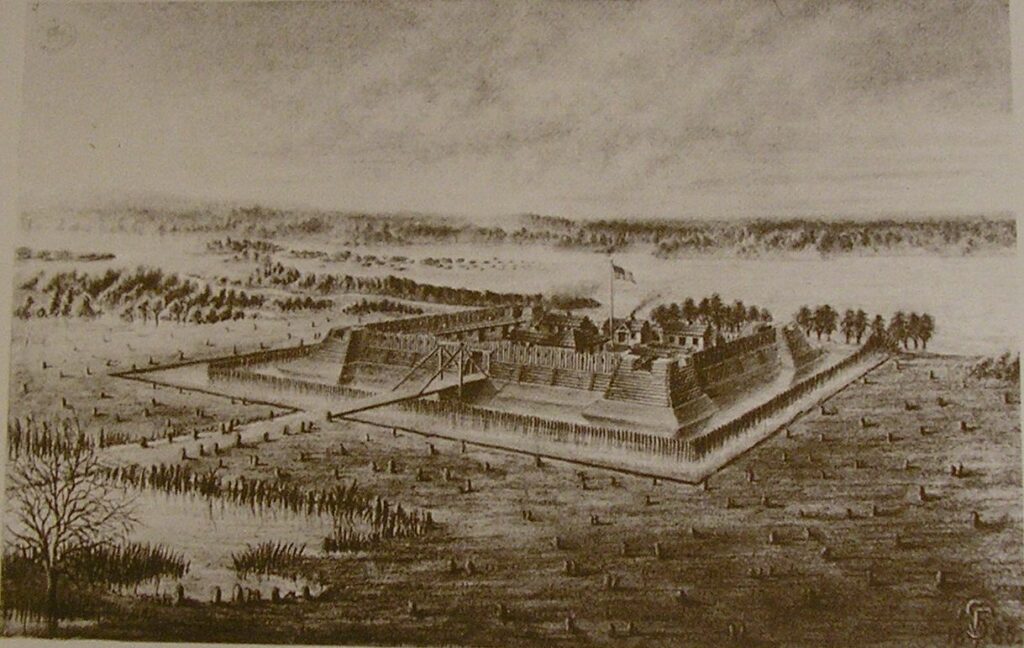
The formidable Fort Nelson stands in the bustling heart of Louisville, specifically on what is now known as Seventh Street Road.
More than just a relic of the past, this fortress symbolizes the city’s crucial role during tumultuous times, serving as a significant stronghold for Union forces.
Today, while the urban sprawl of Louisville envelops the area, the historical importance of Fort Nelson remains palpable.
The juxtaposition of modernity with deep-rooted history makes the fort’s location even more poignant, reminding visitors of the resilience and vision required to build a future while respecting the past.
Cave Hill Cemetery: The Silent Guardians of History
Cave Hill Cemetery is a stone’s throw from Fort Nelson, a hallowed expanse that stands as the region’s oldest cemetery. Amidst its verdant landscapes and meticulously maintained grounds, the cemetery witnesses many stories from the Civil War era.
Particularly significant are the graves of numerous Union officers, who now rest in this tranquil sanctuary. Their tombstones, inscribed with names and ranks, serve as solemn reminders of their service and sacrifice.
The proximity of Fort Nelson to Cave Hill Cemetery offers a narrative of protection and respect.
While the fort was a bastion of defense and strategic operations, the cemetery provided a final resting place for those who dedicated their lives to the Union’s cause.
This relationship between the fort and the cemetery symbolizes the wartime cycle of life, duty, and honor.
7. Fort Knox
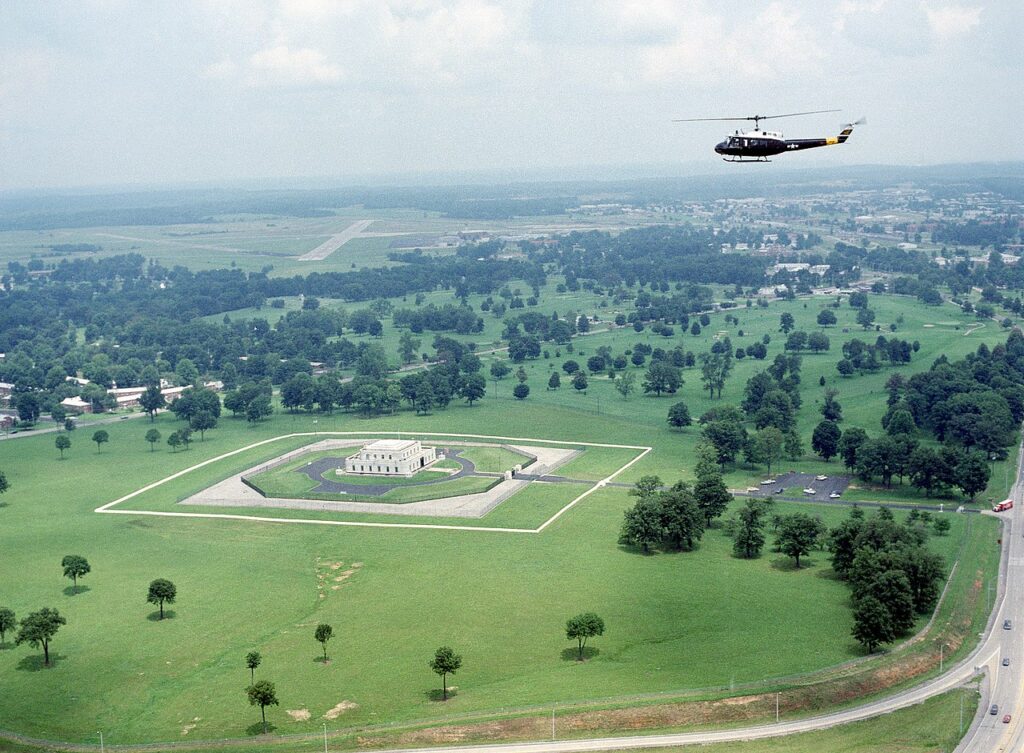
While many associate Fort Knox with the gleaming gold reserves of the United States, its origins are deeply entrenched in the nation’s Civil War history.
It played a pivotal role strategically during this defining period, offering defense and oversight in a country torn by conflict.
For those with a penchant for history, Fort Knox presents a treasure trove of Civil War tales and artifacts.
Detailed exhibits, preserved structures, and guided tours offer an immersive experience, allowing visitors to return to a time of strife, strategy, and sacrifice.
Here, one can trace the footsteps of soldiers, relive key battles, and gain insights into the military strategies employed during the war.
The Golden Transformation: The United States Bullion Depository
Over the years, Fort Knox’s significance has evolved, and it has become synonymous with the United States Bullion Depository.
This transformation from a Civil War bastion to one of the world’s most secure vaults is a testament to its strategic importance. Housing vast quantities of the nation’s gold reserves, the depository symbolizes America’s economic strength and stability.
Bridging Eras: A Unique Confluence
What sets Fort Knox apart is its unique blend of history and modernity. While its walls reverberate with tales of Civil War valor, its vaults echo the clinks of gold bars – representing America’s contemporary might.
This seamless merging of past and present offers visitors a multifaceted experience, making Fort Knox a must-visit for history buffs and those intrigued by the nation’s economic foundations.
8. Fort Heiman
Nestled by the sweeping bends of the Tennessee River, Fort Heiman stands as a sentinel of the South.
Its location, chosen for its proximity to the river, provided the Confederate forces with a vital vantage point, allowing them to monitor and control key passages along this major waterway.
During its heyday, the fort’s walls witnessed intense skirmishes and fierce battles as the Union Army relentlessly pushed forward in their campaigns.
Fort Heiman became a focal point of resistance, with Confederate troops determinedly defending their territory against the Union’s advances.
The cannon fire echoes, the strategies crafted in hurried war rooms, and the courage of countless soldiers defined this fort’s turbulent history.
The Fort’s Legacy
While time has worn down some battlements, Fort Heiman’s legacy as a Confederate stronghold remains intact. The remnants of its defenses, the preserved artifacts, and the interpretive displays paint a vivid picture of its strategic importance during the Civil War.
The fort’s tales of tenacity, bravery, and sacrifice linger in the air, inviting visitors to reflect on the high stakes of war.
Present-day visitors to Fort Heiman are treated to a blend of natural beauty and historical depth.
The serene vistas of the Tennessee River complement the fort’s storied past, creating a unique ambiance that beckons history enthusiasts, scholars, and casual visitors alike.
Walking through its grounds is akin to stepping back in time, offering a profound connection to a pivotal era in American history.
9. Fort Mitchell
Perched strategically, Fort Mitchell has long held significance in the tapestry of America’s military history.
While its origins and specifics may vary based on historical contexts (as there might be multiple Fort Mitchells or changes in its history over time), its legacy as a military establishment remains steadfast.
Throughout its existence, Fort Mitchell played various pivotal roles.
Whether serving as a protective stronghold, a monitoring post, or a base for strategic operations, its position and design were carefully chosen to maximize its military utility.
Over the years, the fort bore witness to the evolution of defense strategies, adapting and rising to the challenges of its era.
Echoes of the Past: Tales and Triumphs
The walls and grounds of Fort Mitchell are steeped in tales of courage, determination, and resilience. From the echoes of marching boots to the silent vigils held during tense times, every corner of the fort has a story to tell.
These narratives highlight military endeavors and illuminate the human spirit’s tenacity in adversity.
Fort Mitchell Today
As the sands of time have shifted, Fort Mitchell has transformed, each era adding another layer to its rich history.
Today, whether preserved as a historical site or repurposed for modern use, Fort Mitchell remains a beacon for history enthusiasts, inviting them to delve into its storied past while appreciating its contemporary relevance.
10. Fort Southworth
Strategically positioned and meticulously constructed, Fort Southworth stands as a sentinel of times gone by. Its foundation speaks volumes about its significance in the grander military and regional narratives schema.
Throughout its operational years, Fort Southworth was more than just a stone and wood structure. It embodied a culmination of strategic insights, playing crucial roles in various confrontations and defensive stances.
Its walls, towers, and battlements saw countless military maneuvers, offering protection and power projection when required.
Whispers from Yesteryears
Every nook and cranny within Fort Southworth tells a tale. The fort has seen everything from the sounds of bugles heralding an advance to the silent nights of vigilance.
These tales aren’t just about military endeavors but also highlight the undying spirit, courage, and determination of those who once walked its corridors and manned its towers.
Fort Southworth in Contemporary Times
Time has added layers of history to Fort Southworth, and today, it serves as a bridge connecting epochs. Its historical roots remain evident whether it’s maintained as a historical site or evolved to serve other purposes.
Visitors today can feel the weight of history and appreciate the fort’s adaptive spirit and ability to stand tall through the ages.
Related: 10 Historic Forts in Massachusetts
Visiting Kentucky’s Forts Today
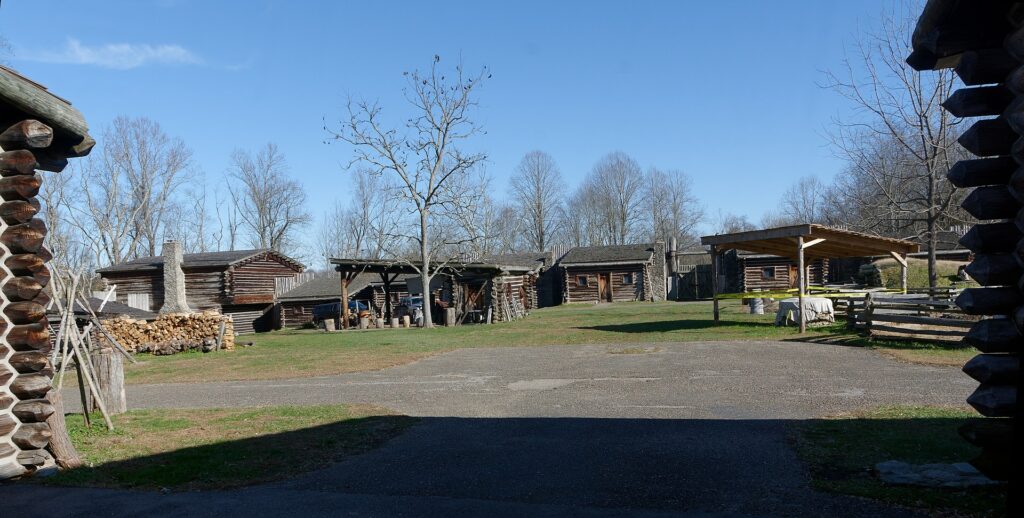
Many of these forts are now listed in the National Register of Historic Places. Organizations such as local historical societies, public libraries, and special interest groups have worked tirelessly to preserve and interpret these sites.
For instance, the Civil War Heritage Trail in central Kentucky is an excellent route for those exploring these forts and other historic homes and sites.
In addition to the forts mentioned, other lesser-known forts like Fort Clark, Fort Clay, Fort Engle, Fort Philpot, Fort McPherson, Fort Horton, Fort Elster, Fort Henry, Fort Karnash, and Fort Donelson also have significant stories to tell.
Special mention goes to Fort Saint Clair Morton on Hill Street, named after a major general who played a pivotal role in the Civil War.
Whether it’s a guided tour of Old Fort Harrod State Park, a walk in the early spring through Fort Duffield Park, or exploring the southern ridge of the Davis Bottom Valley where some forts once stood, Kentucky offers a rich journey through time.
With its forts, the state provides a unique window into America’s past, making it a must-visit for anyone keen on understanding the nation’s history.

Cory is a website owner and content creator who enjoys fishing, history, coin collecting, and sports, among other hobbies. He is a husband and father of four.
Romans 15:4 For whatever was written in former days was written for our instruction, that through endurance and through the encouragement of the Scriptures we might have hope.

